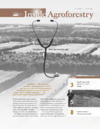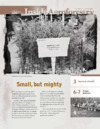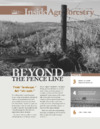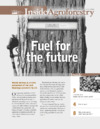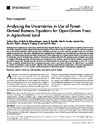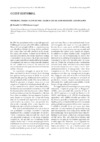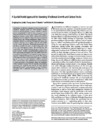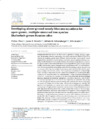Climate Change
Effective beginning 5/30/2025: This website, and all linked websites under the control of the agency is under review and content may change.
Farmers, ranchers, and forest landowners always face challenges posed by weather, however these challenges are getting more frequent and extreme. Our changing climate is a growing concern and evidence suggests that the accumulation of carbon dioxide and other greenhouse gases in the atmosphere has caused, and will continue to cause, incremental warming and other climate change impacts.
Preparing and Responding to Climate Risks
Increased frequency and intensity of extreme weather events such as droughts and floods can lead to yield reductions or crop and livestock losses. Agroforestry can help landowners prepare for and respond to the risks that come from a changing climate.
Flooding
Once established, trees and shrubs are often more drought and flood tolerant than annual plants. Agroforestry practices can help producers adapt to increased rain intensity by intercepting rainfall, increasing infiltration, and reducing the quantity, speed, and peak flows of runoff. For example, conservation buffers in riparian areas and other parts of the landscape can reduce flood and erosion risks for downstream farms and communities by slowing runoff and stabilizing stream banks. Additionally, riparian forest buffer shade can maintain cold-water fish habitat in areas where stream temperatures may rise.

Heat
Predicted higher temperatures may pose a significant challenge for animal production systems. Agroforestry practices can reduce heat stress on livestock by providing shade and moderating the microclimate. Reducing windspeed in the winter by using agroforestry practices, particularly windbreaks, can also lower livestock stress, improve feeding efficiency, and enhance survival during lambing and or calving season.

Wind Erosion
Current wind erosion and airborne dust problems are likely to increase in the future. During the 1930s Dust Bowl, windbreaks were planted in the Great Plains to control wind erosion and protect crops, and they remain a logical choice for addressing the same issues today. Climate change effects and issues will vary regionally and it is important to consider how these differences will influence application of agroforestry in a specific region.

Greenhouse Gases
Agroforestry can also help mitigate climate change by reducing greenhouse gas emissions. Trees and shrubs on agricultural lands can take carbon dioxide out of the air and "store" it in stems and roots. Agroforestry practices can reduce emissions by increasing soil carbon, decreasing fossil fuel usage by reduced equipment runs in fields, enhancing energy conservation around farm buildings, and improving use of nitrogen fertilizer.
Plant Adaptation
To be an effective adaptation and mitigation option, agroforestry plant materials must themselves be adaptable to climate change effects. Changing climatic conditions will impact plant survival and function, which, in turn, determines agroforestry’s effectiveness as a climate-smart strategy. Assessing suitability of species under future climate regimes will be an important step.
Climate Change Publications
Information Sheets
Infosheet

Infosheet

Infosheet

Infosheet

Infosheet

Infosheet

Brochures
Brochure

Inside Agroforestry
Inside Agroforestry

So Many Trees To Choose From
DownloadInside Agroforestry

Extreme Weather
DownloadInside Agroforestry

Breathe In. Okay, Now Breathe Out
DownloadInside Agroforestry

Small, But Mighty
DownloadInside Agroforestry

Beyond The Fence Line
DownloadInside Agroforestry

Fuel For The Future
DownloadInside Agroforestry

... Including The Carbon Sink
Download
Agroforestry Notes
Research
Research

Carbon Dynamics Of Silvopasture Systems In The Northeastern United States
DownloadResearch

Quantifying Greenhouse Gas Sources And Sinks In Cropland And Grazing Land Systems
DownloadResearch

Assessing Silvopasture Management As A Strategy To Reduce Fuel Loads And Mitigate Wildfire Risk
DownloadResearch

A Cultural Landscape Archive: Digitizing The New Deal’s Prairie States Forestry Project
DownloadResearch

Temperate Agroforestry Systems & Insect Pollinators: A Review
DownloadResearch

Agroforestry: Enhancing Resiliency In U.S. Agricultural Landscapes Under Changing Conditions
DownloadResearch

Executive Summary - Agroforestry: Enhancing Resiliency In U.S. Agricultural Landscapes Under Changing Conditions
DownloadResearch

Analyzing The Uncertainties In Use Of Forest-derived Biomass Equations For Open-grown Trees In Agricultural Land
DownloadResearch

Working Trees: Supporting Agriculture And Healthy Landscapes
DownloadResearch

Simulating The Dynamics Of Linear Forests In Great Plains Agroecosystems Unfer Changing Climates
DownloadResearch

Branching Out: Agroforestry As A Climate Change Mitigation And Adaptation Tool For Agriculture
DownloadResearch

Biofuel Feedstock From Riparian Buffers: A Win-win For Climate And Water Quality
DownloadResearch

A Spatial Model Approach For Assessing Windbreak Growth And Carbon Stocks
DownloadResearch

The Use Of Forest-derived Specific Gravity For The Conversion Of Volume To Biomass For Open-grown Trees On Agricultural Land
DownloadResearch

Agroforestry: Working Trees For Sequestering Carbon On Agricultural Lands
DownloadResearch

Building Bigger Better Buffers For Bioenergy
DownloadResearch

Developing Above-ground Woody Biomass Equations For Open-grown, Multi-stemmed Tree Species: Shelterbelt-grown Russian-olive
DownloadResearch

Agroforestry-Working Trees For Sequestering Carbon On Ag-Lands
DownloadResearch

CBD Technical Series No. 10 - Interlinkages Between Biological Diversity And Climate Change
Download










